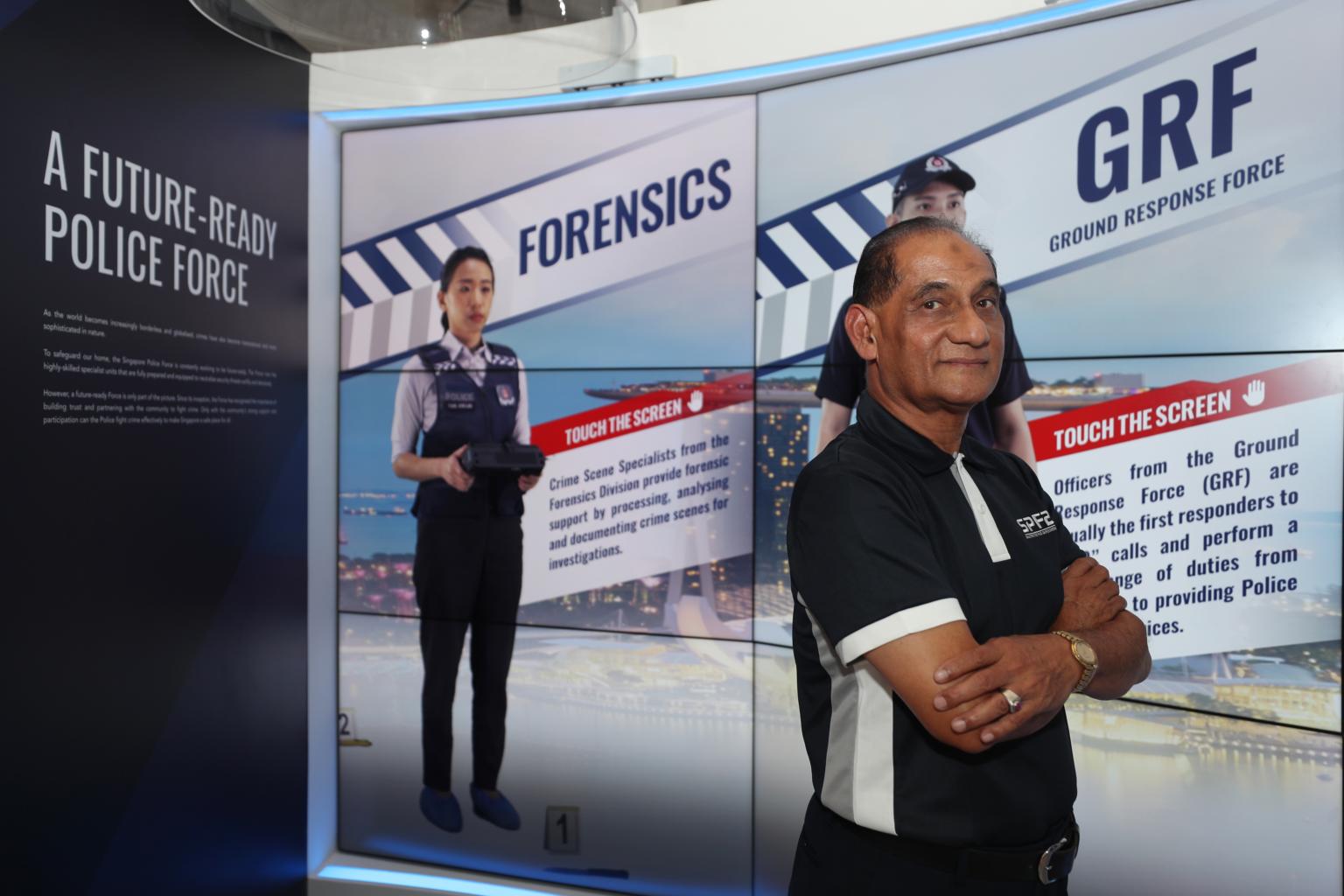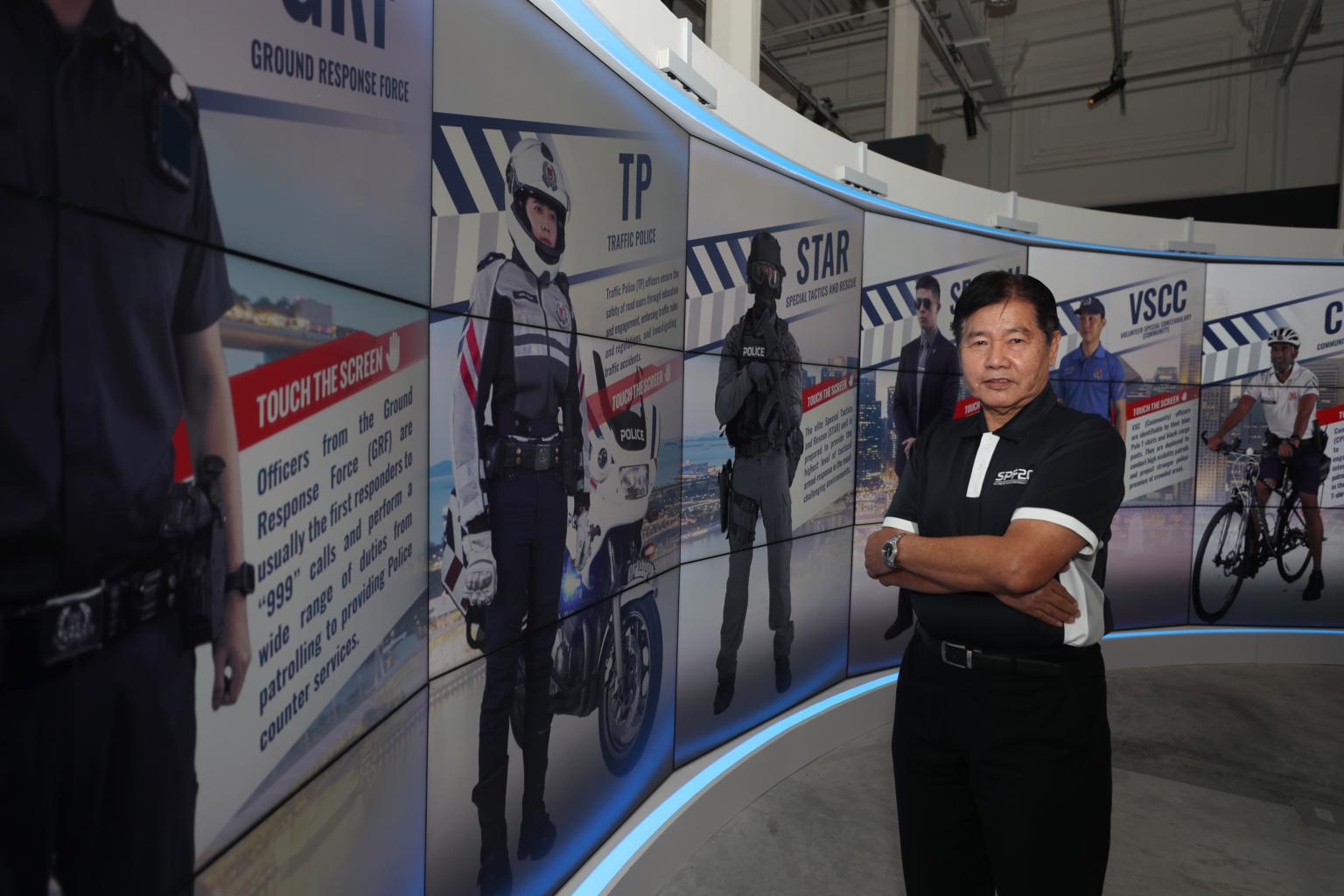Singapore policemen share stories of secret societies, hell riders and cold-blooded murders
Sign up now: Get ST's newsletters delivered to your inbox

(From left) Mr Chan Soo Wah, 74, exhibition guide and retired police officer; Supt Abdul Halim Osman, 55, serving police officer; and Mr Nasir Said, 65, exhibition guide and retired police officer.
ST PHOTO: TIMOTHY DAVID
Cara Wong, Zaihan Mohamed Yusof
Follow topic:
SINGAPORE - As the police celebrate their 200th anniversary with an exhibition at the National Museum of Singapore, The Straits Times speaks to past and present police officers who have been part of the police force's transformation.
Superintendent Abdul Halim Osman, 55

It was a daring, cold-blooded execution-style murder rarely seen in Singapore.
Nightclub owner Lim Hock Soon was shot in his home on Feb 15, 2006, right in front of his distraught family.
When Superintendent Abdul Halim Osman's team of Criminal Investigation Division officers got to the scene, the body was still on the floor with five bullet holes.
The scene was chaotic, with Mr Lim's distressed wife, daughter and maid in the same flat.
"We had to control the situation and manage the witnesses. It was important that we got the most information from them," said Supt Abdul Halim, 55, who was the investigation officer of the case.
It was also imperative that they manage the scene properly as the consequences were severe, he said. The murder charge carries the death penalty.
"We must be 100 per cent sure that we don't make any mistakes," he said.
The police spent the next two to three days processing the scene, collecting evidence and speaking to the witnesses.
They found out the killer's nickname, Tony Kia, and with that they eventually managed to establish the man's real name as Tan Chor Jin, 39, a member of the Ang Soon Tong gang. He was also dubbed the "One-Eyed Dragon" because of his one blind eye.
But Tan had fled to Malaysia, and the police relied on their counterparts there to nab him 10 days after the murder, said Supt Abdul Halim.
Tan was sent back to Singapore and tried. He was found guilty and hanged in 2009.
Despite having handled several other murder cases, Supt Abdul Halim still considers the One-Eyed Dragon case memorable for the sheer audacity of a killer who shot a man in front of witnesses.
"I don't think we can find such cases like this in Singapore. It was very aggressive, so we had to get him."
Mr Nasir Said, 65, retired police officer and exhibition guide

The retired police officer's face lit up when he spoke about police motorcycles and hell riders of the 1970s and 1980s.
Senior Station Inspector 2 Nasir Said, a former Traffic Police officer and trainer, recalled high-speed chases and waiting in cemeteries to ambush hell riders who raced their motorbikes along Lim Chu Kang's famed "40 tiang" stretch.
The long hours of waiting meant that officers like him often became targets for blood-sucking insects, said Mr Nasir, who joined the Singapore Police Force in 1972.
But his long 32-year career, which was followed by another 13 years of re-employment, nearly ended prematurely.
Mr Nasir contemplated leaving the force after the death of a squad mate in 1983 during a night escort mission.
"I was very shocked," said Mr Nasir, who is one of the guides for the SPF200 exhibition at the National Museum of Singapore.
"He was close to me - we were brought up together. He was the one who had encouraged me to join the mobile squad."
Mr Nasir had been leading the escort of a small RSAF aircraft when his colleague at the rear of the convoy hit a divider and crashed into one of the airplane's wings.
The officer, who had come from the same village in Jalan Kubis (now Ubi) as Mr Nasir, died before reaching a hospital from a broken rib puncturing his heart.
But Mr Nasir did not know it then, as there was no physical bleeding detected.
After being told of his friend's death at the hospital, Mr Nasir became distraught and was unable to convey news of the accident to the man's family.
His senior officers understood Mr Nasir's predicament. They allowed him to take a break during that difficult time.
To this day, he is grateful and said he cannot forget the good support from family members and the management.
Mr Chan Soo Wah, 74, retired police officer and exhibition guide

When Mr Chan Soo Wah was a Secondary 4 student, gangsters robbed him of his watch at knifepoint. That encounter sealed his decision to join the Singapore Police Force.
Mr Chan, who joined in December 1965 and retired in 1999 with the rank of Deputy Superintendent of Police, was not looking for revenge.
In fact, he was fascinated by the police officer who had handled his case.
Said Mr Chan, 74, one of the guides for the SPF200 exhibition at the National Museum of Singapore: "I was impressed with him... This investigator was thorough in his work."
Mr Chan's brush with gangsters did not end there.
Starting his career as a constable dressed in khaki shorts, he worked his way up the ranks, graduating from the police academy as an inspector and later moving to the Criminal Investigation Department's secret society branch to monitor Cantonese gangs.
Singapore's tough laws, namely the Criminal Law Temporary Provisions Act - known to some in Hokkien as "go chap go" (55, for Section 55 of the Act) - kept secret societies in check in the mid-1970s.
Mr Chan said Section 55 gave the police powers to detain a secret society member without trial. "That's how we broke the backbone of the secret society menace."
A decade earlier, in the 1960s, tensions arose due to student protests, the communist threat and the post Konfrontasi era.
The bombing of MacDonald House in Orchard Road by Indonesian saboteurs in March 1965 left three people dead and 35 others injured.
The police received frequent calls whenever the public spotted suspicious items.
Mr Chan remembers one of these calls in 1969 vividly.
He was responding to an evening call about an abandoned shoe box left in front of a British company in Bukit Timah.
A young and tired probationary Inspector Chan had assumed it was just another bomb hoax and was about to kick the box.
But an elderly Volunteer Special Constabulary officer, who was first at the scene, held on to Mr Chan's thigh tightly and pleaded with him not to kick the box.
Luckily, Mr Chan listened to him because the bomb disposal unit later confirmed that the box was rigged with explosives.
"I'm here today because I survived and was saved by him."

